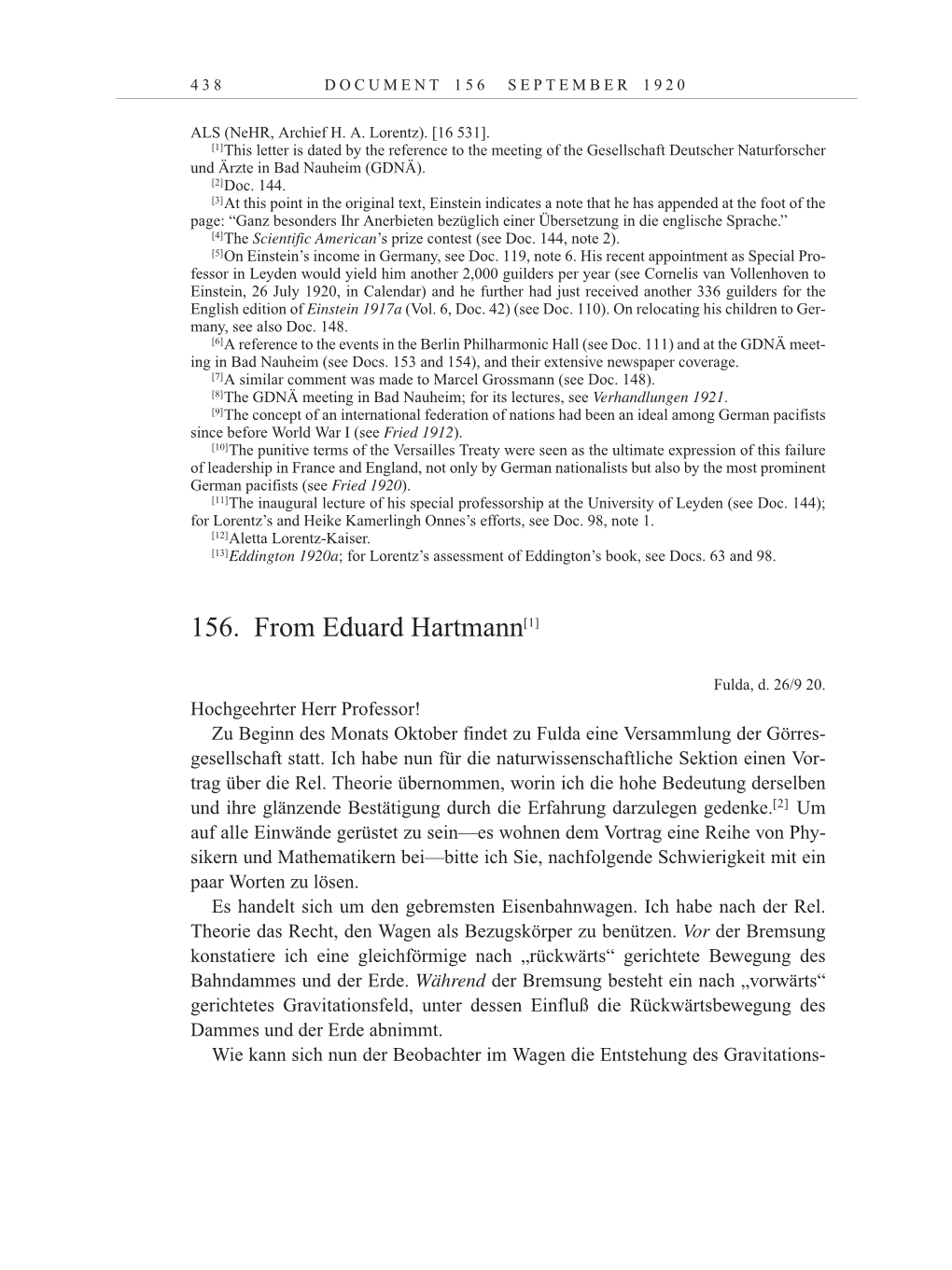4 3 8 D O C U M E N T 1 5 6 S E P T E M B E R 1 9 2 0
ALS (NeHR, Archief H. A. Lorentz). [16 531].
[1]This letter is dated by the reference to the meeting of the Gesellschaft Deutscher Naturforscher
und Ärzte in Bad Nauheim (GDNÄ).
[2]Doc. 144.
[3]At this point in the original text, Einstein indicates a note that he has appended at the foot of the
page: “Ganz besonders Ihr Anerbieten bezüglich einer Übersetzung in die englische Sprache.”
[4]The Scientific American’s prize contest (see Doc. 144, note 2).
[5]On Einstein’s income in Germany, see Doc. 119, note 6. His recent appointment as Special Pro-
fessor in Leyden would yield him another 2,000 guilders per year (see Cornelis van Vollenhoven to
Einstein, 26 July 1920, in Calendar) and he further had just received another 336 guilders for the
English edition of Einstein 1917a (Vol. 6, Doc. 42) (see Doc. 110). On relocating his children to Ger-
many, see also Doc. 148.
[6]A reference to the events in the Berlin Philharmonic Hall (see Doc. 111) and at the GDNÄ meet-
ing in Bad Nauheim (see Docs. 153 and 154), and their extensive newspaper coverage.
[7]A similar comment was made to Marcel Grossmann (see Doc. 148).
[8]The GDNÄ meeting in Bad Nauheim; for its lectures, see Verhandlungen 1921.
[9]The concept of an international federation of nations had been an ideal among German pacifists
since before World War I (see Fried 1912).
[10]The punitive terms of the Versailles Treaty were seen as the ultimate expression of this failure
of leadership in France and England, not only by German nationalists but also by the most prominent
German pacifists (see Fried 1920).
[11]The inaugural lecture of his special professorship at the University of Leyden (see Doc. 144);
for Lorentz’s and Heike Kamerlingh Onnes’s efforts, see Doc. 98, note 1.
[12]Aletta Lorentz-Kaiser.
[13]Eddington 1920a; for Lorentz’s assessment of Eddington’s book, see Docs. 63 and 98.
156. From Eduard Hartmann[1]
Fulda, d. 26/9 20.
Hochgeehrter Herr Professor!
Zu Beginn des Monats Oktober findet zu Fulda eine Versammlung der Görres-
gesellschaft statt. Ich habe nun für die naturwissenschaftliche Sektion einen Vor-
trag über die Rel. Theorie übernommen, worin ich die hohe Bedeutung derselben
und ihre glänzende Bestätigung durch die Erfahrung darzulegen
gedenke.[2]
Um
auf alle Einwände gerüstet zu sein—es wohnen dem Vortrag eine Reihe von Phy-
sikern und Mathematikern bei—bitte ich Sie, nachfolgende Schwierigkeit mit ein
paar Worten zu lösen.
Es handelt sich um den gebremsten Eisenbahnwagen. Ich habe nach der Rel.
Theorie das Recht, den Wagen als Bezugskörper zu benützen. Vor der Bremsung
konstatiere ich eine gleichförmige nach „rückwärts“ gerichtete Bewegung des
Bahndammes und der Erde. Während der Bremsung besteht ein nach „vorwärts“
gerichtetes Gravitationsfeld, unter dessen Einfluß die Rückwärtsbewegung des
Dammes und der Erde abnimmt.
Wie kann sich nun der Beobachter im Wagen die Entstehung des Gravitations-
